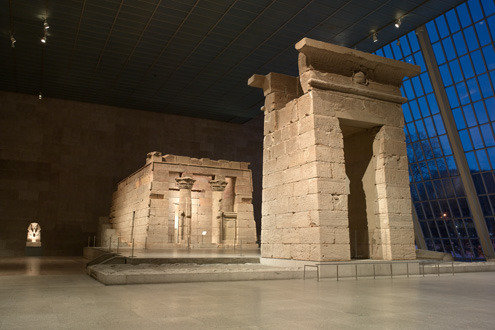The Dawn of Egyptian Art
dal 9/4/2012 al 4/8/2012
Segnalato da
9/4/2012
The Dawn of Egyptian Art
Metropolitan Museum of Art - MET, New York
Origins of Ancient. The exhibitions features some 180 examples of the very earliest works of Egyptian art - created in the Predynastic and Early Dynastic periods, around 4400 B.C.-2649 B.C. (the end of Dynasty 2) from throughout Egypt. The show includes depictions of landscapes painted on vessels, objects in the form of different animals and humans.

curated by Renée Friedman, Ann Macy Roth, Marianne Eaton-Krauss, and David P. Silverman
Some 180 examples of the very earliest works of Egyptian art—created in the Predynastic and Early Dynastic periods, around 4400 B.C.–2649 B.C. (the end of Dynasty 2) from throughout Egypt—will be featured in the exhibition The Dawn of Egyptian Art, opening April 10, 2012, at The Metropolitan Museum of Art. Outstanding examples of sculpture, painting, and relief from the collections of the Metropolitan and 12 other museums in the United States and Europe have been gathered for this presentation.
“Visitors who are familiar with the appearance of hieroglyphs and other later Egyptian artistic expressions will be surprised by these early works, which are very different in scale, style, and subject matter,” commented exhibition organizer Diana Craig Patch. “Yet, if we look closely at this early art, we can already detect the origins of certain signs in later hieroglyphic writing and of some symbols and concepts associated with ancient Egyptian rulers and the gods. The Predynastic and Early Dynastic period was a time of great creativity, before the ‘typically Egyptian’ forms became codified. Yet, because of the rarity of these objects and lack of inscriptions, we cannot always explain what they meant to the early Egyptians.”
The exhibition includes depictions of landscapes painted on vessels, objects in the form of different animals—grouped by habitat (river, air, or desert)—and humans. Certain groupings will also reflect the important themes of fertility and renewal, and chaos versus order.
Animals occur frequently in early Egyptian art, and the exhibition is particularly rich in images of hippos and crocodiles, turtles, and fish; antelopes, cattle, elephants, baboons, lions, and canids (jackals and dogs); ostriches, ducks, and falcons; and scorpions and snakes. Probably because of certain attributions or characteristics, some animals grew in importance during this period, and they carried forward as symbols in later Egyptian culture, while others disappearbut possibly a few lessllPeriodtributions or characteristics, some, and fish; antelopes, aurochs, ducks and falcons, n Hendrickxed.
Depictions of humans are of two types: realistic figurines in bone or ivory that depict the entire human body; and abstracted forms in clay, mud, ivory, or stone in which the figures often lack arms, have missing or poorly formed legs, or have beak-like faces that emphasize the nose. All figurines have attributes that identify their gender clearly. Evidence indicates that some figurines were made to represent a specific activity and that their position in tombs was not arbitrary.
The exhibition will be accompanied by a lavishly illustrated catalogue by the exhibition’s curator, with essays by Renée Friedman, Ann Macy Roth, Marianne Eaton-Krauss, and David P. Silverman. The publication will be available in the Museum’s book shops ($60, hard cover).
An audio tour, part of the Metropolitan's Audio Guide program, will be available for rental ($6, $5 for members, and $4 for children under 12).
The Audio Guide program is sponsored by Bloomberg.
In conjunction with the exhibition, a variety of education programs will be scheduled. These will include lectures and exhibition tours for adult visitors, and three workshops—one for teachers, one for families with young children, and an additional family workshop for people with learning and cognitive disabilities. A Sunday at the Met program on May 13 will focus on the topic of the ritual hunt in the Predynastic Period, with presentations by Diana Craig Patch, Associate Curator, Department of Egyptian Art, The Metropolitan Museum of Art; Renée Friedman, Director of the Hierakonpolis Expedition; and Stan Hendrickx, a noted scholar of the Predynastic Period.
The Museum's website (www.metmuseum.org) will include a special feature about the exhibition.
The exhibition is organized at the Metropolitan by Diana Craig Patch, Associate Curator, Department of Egyptian Art. Exhibition design is by Michael Lapthorn, Exhibition Design Manager; graphics are by Norie Morimoto, Graphic Designer; and lighting is by Clint Ross Coller and Rich Lichte, Senior Design Managers, all of the Museum’s Design Department
Communications Department
tel (212) 570-3951 fax (212) 472-2764 communications@metmuseum.org
Press preview: Monday, April 2, 10:00 a.m.-noon
Opening 10 april
Robert Lehman Wing, Gallery 964 and 965 (court level)
Metropolitan Museum of Art MET
1000 Fifth Avenue at 82nd Street New York
Hours: Tuesday–Thursday: 9:30 a.m.–5:30 p.m. Friday and Saturday: 9:30 a.m.–9:00 p.m. Sunday: 9:30 a.m.–5:30 p.m.(Galleries are cleared fifteen minutes before closing). Closed Monday (except Met Holiday Mondays), Thanksgiving Day, December 25, and January 1. Saturday Evenings are made possible by the William H. Kearns Foundation.
Admission: adults $25, seniors (65 and older) $17, students $12, members (Join Now) free, children under 12 (accompanied by an adult) free.



